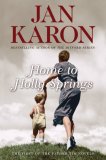Make Your Writing Sing: Add Great Dialogue
 In Home to Holly Springs
In Home to Holly Springs, the latest installment in the best-selling Mitford Series, Jan Karon creates characters so real, you feel as if you’ve known them your whole life. She’s one of the few authors who can—in the course of one page—elicit both laughter and tears from me.
Her books harken back to the good old days of literature, when conversation was king and relationships ruled. Her characters engage in sparkling, unembellished dialogue that speaks for itself.
In this excerpt, Father Tim advises his two new buddies, T and Ray, what to name the product they’ve just created—a Kudzu-based cream that makes hair grow on bald spots:
T stooped over the chair and pointed to the top of his head. “Feel this,” he said.
He raised his forefinger and felt it.
“Fuzzy.”
“Dern right. Fuzzy as a peach. About a week, an’ we got fuzzy. It’s gon’ work.”
“Good timing. I might have a name for you.” He’d finagled it out of his feeble brain one night at the hotel.
“Shoot,” said T.
“But remember I’m a preacher. I’m not a marketing maven.”
“Yeah,” said Ray, “but bein’ a preacher puts you in sales, an’ that’s good enough for us.”
“Let’s start with packaging, so when I get to the name, you can, you know, imagine the way the name will look to the consumer.”
“Good deal,” said T.
“A white tube.”
“We’re with you,” said T.
“Blue lettering. I read a study that said men like the color blue—has authority.”
“What about women?” said Ray. “We don’t want t’ lose out on that demographic.”
“I didn’t get that far,” he said. “But I’ll keep it in mind. For the lettering, I’d use bold type. Sans serif.” He’d done pew bulletins, he knew this stuff. “Sans serif is more contemporary, though I’m a serif man, myself. Okay. Here’s the name…”
You could hear a pin drop.
“Mo’ Hair.”
“I don’t get it,” said Ray.
“Try again,” said T. “If you don’t mind.”
“Okay. You’ll like this. Hair to Spare.”
“Man! said T. “Hair to Spare. That’s it. I like it. I really like it.”
What did you learn from this snippet?
- In what part of the world do you think the story takes place?
- What do you learn about each of the characters?
- How old are the characters?
- What kind of a relationship do the characters have with one another?
Now, examine Jan Karon’s dialogue-writing technique:
- How often does she include an attribution? (the “said so and so”)
- In what part of the sentence does she include the attribution?
- How often do the characters speak in incomplete sentences?
- How often does the author insert narration? How does the narration move or slow down the dialogue?
Many writers and bloggers believe dialogue is only for fiction. I disagree! I almost always weave snippets of dialogue into my non-fiction articles, book chapters, blog posts — even Twitter updates.
Dialogue puts you–the reader–right in the story; it helps you vicariously “live” the story.
Your challenge: Work it!
- Using what you just learned about writing dialog from Jan Karon, add a conversation (using direct quotes) into your next blog article.
- Post a link to your blog article in the Comments. I’ll read your blog post and give you some feedback.

Leave a Reply